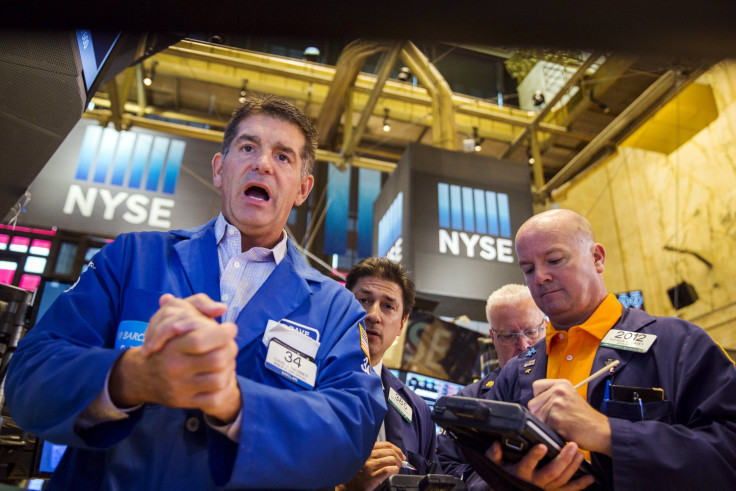Dow Jones Industrial Average Plunges On Weak August Jobs Report

This story was updated at 4 p.m. EDT
U.S. stocks closed sharply lower Friday after the economy added fewer-than-expected jobs in August, suggesting the Federal Reserve will hold off on raising interest rates at its meeting later this month. Equities pared losses in the final hour of trading Friday, with the Dow Jones Industrial Average closing down 272 points after falling as much as 345 points in the afternoon.
Despite paring some losses, all three major indexes lost 3 percent for the week.
“Uncertainty and speculation will drive emotion over the next couple of weeks in the stock market ahead of the Fed's decision,” said Terry Sandven, chief equity strategist at U.S. Bank Wealth Management.
The Dow Jones Industrial Average (INDEXDJX:.DJI) dropped 272.32 points, or 1.66 percent, to 16,102.44. The Standard & Poor's 500 index (INDEXSP:.INX) fell 29.89 points, or 1.53 percent, to 1,921.23. The Nasdaq composite (INDEXNASDAQ:.IXIC) sank 49.58 points, or 1.05 percent, to 4,683.92.
The major averages lost roughly 1 percent Friday, while the yield on the 10-year treasury fell to 2.13 percent, signaling investors are betting against the Fed raising rates.
“As far as we’re concerned, the September meeting is a 50-50 toss-up,” Paul Ashworth, chief U.S. economist at Capital Economics, said in a note.
All 10 sectors in the S&P 500 closed lower, led by a 2 percent decline in financial and material stocks. Every sector closed at least 1 percent lower. The Energy, consumer staples and telecom sectors sank roughly 1.5 percent.
Energy and financials also led the Dow lower, with all 30 stocks in the blue-chip index closing in the red. The declines were led by a 3 percent decline from chemical maker DuPont Co. (NYSE:DD), while bank giants JPMorgan Chase & Co. (NYSE:JPM) and Goldman Sachs Group Inc. (NYSE:GS) lost 2.2 percent and 1.9 percent, respectively.
The financials likely declined Friday because the sector doesn't benefit if the Fed holds off on hiking rates this year.
Oil prices traded pared losses in afternoon trading Thursday after a weekly count of U.S. oil rigs fell for the first time in six weeks, signaling drillers were scaling back production amid a drop in crude prices. The number of rigs in U.S. oilfields fell by 13 to a total of 662 for the week ending Sept. 4, compared with 1,584 at this time last year, Baker Hughes said.
Following the report, West Texas Intermediate crude, the benchmark for U.S. oil prices, fell 1.5 percent to close at $46.05 per barrel for October delivery on the New York Mercantile Exchange. On the London ICE Futures Exchange, Brent crude, the global benchmark for oil prices, lost 2 percent to $50.40.
Job growth in August was somewhat disappointing at just 173,000, but the upward revisions to June and July suggest it's too early to conclude that the U.S. economy is experiencing a moderation in job growth, says Gad Levanon, director of macroeconomic and labor market research at the Conference Board.
“Given that the labor force is barely growing at all, current job growth rates will continue to rapidly lower the unemployment rate to below 5 percent by year’s end,” Levanon said in a research note.
The mixed employment report for August, coupled with the recent stock market turmoil over concerns of a slowing global economy, could make central bankers pause before lifting interest rates at the Fed’s meeting on Sept. 16-17.
U.S. employers added 173,000 jobs in August, fewer than widely expected, but the unemployment rate still edged down to 5.1 percent, its lowest level since April 2008, the Labor Department said Friday.
While the decline in unemployment may appear disappointing, the figure is discouraging to economists because more people are giving up on finding work in the U.S. labor force. Last month, the number of long-term unemployed (those jobless for 27 weeks or more) held at 2.2 million in August and accounted for 27.7 percent of the unemployed.
“The job growth this month continues in the right direction but shows we still have almost five more years at this pace to get the share of young adult workers (those 20-24) back to the level of employment they had at their last peak in 2007 – too late for the current cohort,” William Spriggs, chief economist at the AFL-CIO, said in a note.
© Copyright IBTimes 2025. All rights reserved.






















